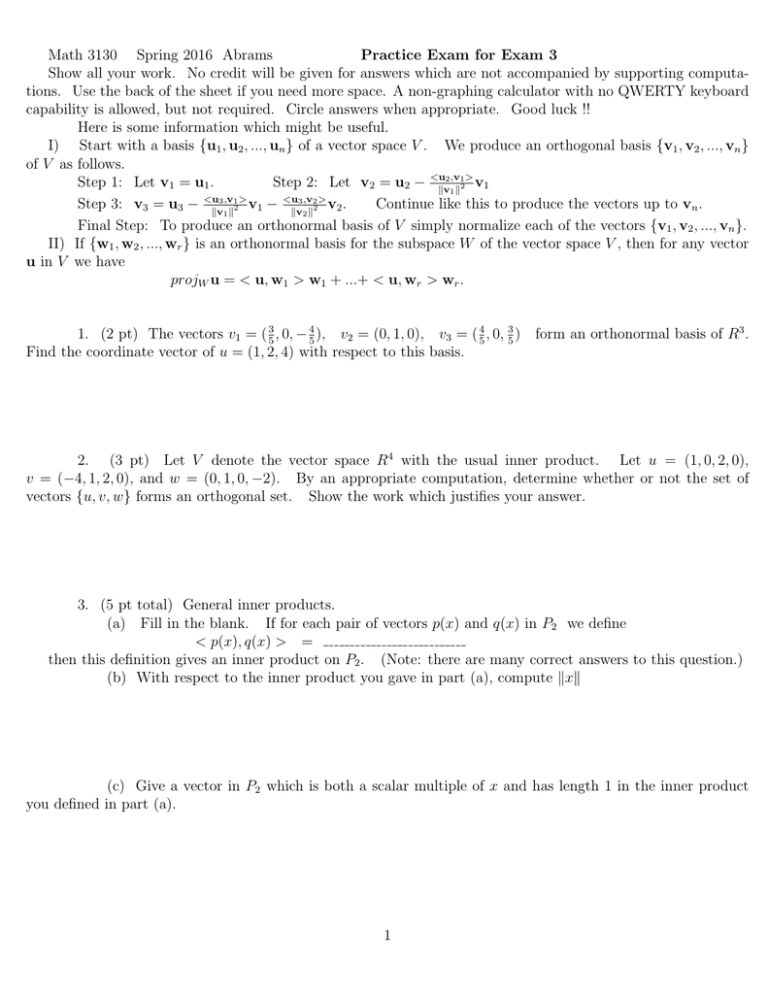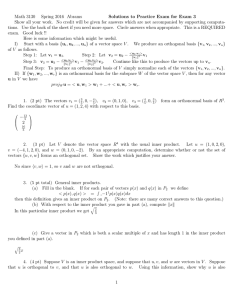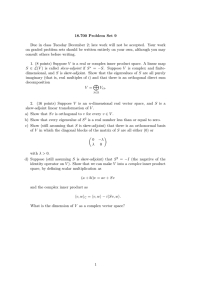Math 3130 Spring 2016 Abrams Practice Exam for Exam 3
advertisement

Math 3130 Spring 2016 Abrams
Practice Exam for Exam 3
Show all your work. No credit will be given for answers which are not accompanied by supporting computations. Use the back of the sheet if you need more space. A non-graphing calculator with no QWERTY keyboard
capability is allowed, but not required. Circle answers when appropriate. Good luck !!
Here is some information which might be useful.
I) Start with a basis {u1 , u2 , ..., un } of a vector space V . We produce an orthogonal basis {v1 , v2 , ..., vn }
of V as follows.
Step 1: Let v1 = u1 .
Step 2: Let v2 = u2 − <ukv2 ,vk12> v1
1
Step 3: v3 = u3 − <ukv3 ,vk12> v1 − <ukv3 ,vk22> v2 .
Continue like this to produce the vectors up to vn .
1
2
Final Step: To produce an orthonormal basis of V simply normalize each of the vectors {v1 , v2 , ..., vn }.
II) If {w1 , w2 , ..., wr } is an orthonormal basis for the subspace W of the vector space V , then for any vector
u in V we have
projW u = < u, w1 > w1 + ...+ < u, wr > wr .
1. (2 pt) The vectors v1 = ( 35 , 0, − 54 ), v2 = (0, 1, 0), v3 = ( 45 , 0, 35 ) form an orthonormal basis of R3 .
Find the coordinate vector of u = (1, 2, 4) with respect to this basis.
2. (3 pt) Let V denote the vector space R4 with the usual inner product. Let u = (1, 0, 2, 0),
v = (−4, 1, 2, 0), and w = (0, 1, 0, −2). By an appropriate computation, determine whether or not the set of
vectors {u, v, w} forms an orthogonal set. Show the work which justifies your answer.
3. (5 pt total) General inner products.
(a) Fill in the blank. If for each pair of vectors p(x) and q(x) in P2 we define
< p(x), q(x) > =
then this definition gives an inner product on P2 . (Note: there are many correct answers to this question.)
(b) With respect to the inner product you gave in part (a), compute kxk
(c) Give a vector in P2 which is both a scalar multiple of x and has length 1 in the inner product
you defined in part (a).
1
4. (4 pt) Suppose V is an inner product space, and suppose that u, v, and w are vectors in V . Suppose
that u is orthogonal to v, and that u is also orthogonal to w. Using this information, show why u is also
orthogonal to the vector 2v − 3w.
5. (a) (5 pt) Let R3 have the usual inner product. Find an orthonormal basis for the subspace W of
R3 which is spanned by (0, 2, 0) and (−1, 0, 1).
(b) (2 pt) If e1 denotes (as usual) the vector (1, 0, 0) in R3 , compute projW (e1 ).
6. (1 pt each) Short answer
(a) The n × 1 column vector z is an eigenvector for the n × n matrix A corresponding to the eigenvalue
λ in case z 6= 0 and
(b) If u and v are orthogonal vectors in an inner product space V , and we know kuk = 3, kvk = 2,
compute ku + vk2 .
2
2 0 0
7. . (10 pt total) Let A denote the matrix 0 3 0 .
−2 0 3
(a) Find the eigenvalues for A.
(b) For each of the values you computed in part (a), compute a basis of the corresponding eigenspace.
(c) Let B 0 denote the basis of R3 gotten by using your answer to part (b). Let P denote the transition
matrix from B 0 to B. Find P .
(d) Compute P −1 AP.
(e) ’Compute’ A100 . Your answer may contain real numbers raised to powers, and may contain the
inverse of a matrix (which you need not compute explicitly). Your answer must be written as the product of three
or fewer matrices.
3
8. (6 pt total) We will go through some of the steps required to find the general solution to the system of
linear differential equations
y10 = y1 + y2
0
y2 . = −2y1 + 4y2
(a) If we write the system as a matrix equation of the form Y 0 = AY, then
A=
It turns out that the matrix A has eigenvalue 2, with corresponding eigenvector (1, 1), and eigenvalue 3, with
corresponding eigenvector (1, 2). We introduce new variables u1 and u2 , which are related to the variables y1
and y2 by the equation Y = P U, where P is the transition matrix from the new basis of R2 consisting of the two
given eigenvectors to the standard basis.
(b) By substituting values appropriately, give a matrix equation which involves the matrices U, A, and
P which expresses the equation Y 0 = AY as a system in terms of the new variables u1 and u2 .
(c) Solve the system corresponding to the matrix equation given in (b); that is, solve for the variables
u1 and u2 .
(d) Give the general solution to the original system of differential equations.
9. (1 pt each) True - False and Short answer.
(a) T
F
If A is a 3 × 3 matrix and A has only two real eigenvalues, then there cannot be an
invertible matrix P and a diagonal matrix D with the property that D = P −1 AP.
(b) T
F If A is a 3 × 3 matrix with the property that λ = 1, λ = 2, and λ = 3 are each eigenvalues
for A, then there exists an invertible matrix P with the property that P −1 AP is a diagonal matrix.
(c) T
F
The eigenvalues of a diagonal matrix D are the entries on the main diagonal of D.
(d) T
F
If u, v, and w are vectors in an inner product space, and u is orthogonal to v, and v is
orthogonal to w, then necessarily u is orthogonal to w.
4




